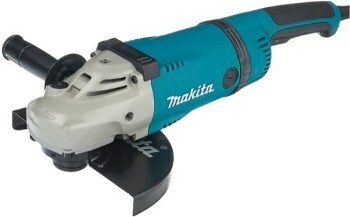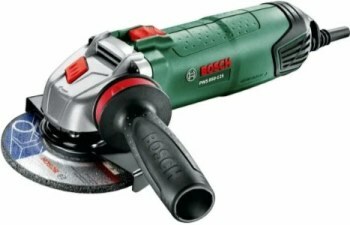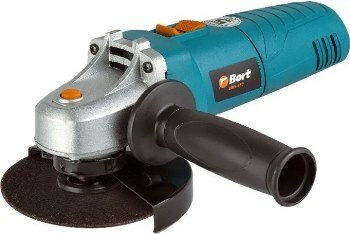An angle grinder is often a completely indispensable tool, capable of more than just grinding. The grinders both cut and clean, they are used when working with wood, and with metal, and with stone and concrete. About how to choose them correctly, which 3 angle grinders are worthy of the title of the best and why Bulgarians are called exactly Bulgarians - I'll tell you now.
CONTENT
- 1 What is an angle grinder and why is it called a grinder
- 2 What are the grinders
- 3 How to choose a grinder: parameters and criteria
- 4 Top best Bulgarians (LBM)
- 5 Popular questions
- 6 conclusions
What is an angle grinder and why is it called a grinder
An angle grinder or angle grinder is a device in which the axis of the motor and the axis of rotation of the tool (cutting disc or brush) are located at right angles to each other. Actually, therefore, and "angular". Grinding machines are used for, in fact, grinding, stripping and cutting almost any material: thanks to the high performance of angle grinders, they do an excellent job even with wood, even with metal, even with stone.
Cutting discs of various diameters, brushes made of metal and nylon, as well as end flap wheels for polishing are used as accessories for angle grinders. Some intellectuals screw circles from circular saws to grinders, but I do not advise you to do that. Unless, of course, you have spare fingers, hands, feet, eyes and, just in case, lives. But let's not talk about sad things.
So why is it a "Bulgarian"? In fact, everything is elementary. The first angle grinders under the Eltos trademark were brought to the then Soviet Union from Bulgaria. Because of this, new devices for our masters began to be called grinders. By the way, the Sparky Eltos enterprise in Lovech, Bulgaria, is still the largest manufacturer of power tools in Europe.
What are the grinders
There are a variety of approaches to the classification of angle grinders, but in practice, most often they use the division of tools by type of power: into network, rechargeable, pneumatic and gasoline.
The most common grinders both in the household and in the professional sphere are electric. Since grinders usually require high power, grinders are usually powered from the mains. Plugging to an outlet, of course, seriously limits mobility, but it gives almost endless possibilities for electricity consumption. This means that manufacturers can install engines with a capacity of several kilowatts in such devices, for which neither metal nor stone will be a serious obstacle. The key parameter for such tools is the engine power, which usually fluctuates between 1000-3000 watts. The higher the power, the more productive the grinder is.
Cordless grinders do not work from the mains, but from replaceable batteries. On the one hand, this greatly expands the scope of their application. After all, you can work with a cordless grinder even where there is no electricity at all: in the country or at a construction site, for example. And in an electrified apartment, it is much more convenient to use a tool without dragging a thick cable. On the other hand, the performance of such grinders is limited by the capabilities of modern batteries. Their performance is usually slightly lower than that of network models, and with a discharged battery, there is no sense from rechargeable angle grinders. Nevertheless, for most everyday tasks, they are no worse than their network counterparts.
Pneumatic grinders are much less common than electric ones. It is a dedicated compressed air tool for professionals. Therefore, if you don't have the right compressor, if you don't build houses or cut pipes for hours every day, then you don't need an air sander either.
The same can be said about gasoline angle grinders - gas cutters. These are heavy and powerful devices that are powered by internal combustion engines. They are never used in everyday life, but they are used very actively for complex tasks in construction.
In addition to the way of eating, grinders are divided into household and professional ones. This is a very arbitrary division, which allows you to delimit models of different price ranges and functionality. A professional tool is usually much more expensive than a household one, but is capable of withstanding much higher loads and calmly survives continuous many hours of daily use. Household models are simpler and are not designed for such treatment, but they are much cheaper. In addition, among them there are very interesting and extremely reliable specimens.
Finally, grinders can be one-handed or two-handed. Tools of the first type are lighter, more compact and designed for one-handed operation. Two-handed models, in turn, are heavier and more powerful - they are designed to solve more complex problems.
How to choose a grinder: parameters and criteria
When choosing an angle grinder, you should pay attention to several basic parameters.
- Working disk dimensions. The cutting disc is the main working tool of the grinder. Discs for professional gas cutters can reach a diameter of 400 mm, but such dimensions are not found in household devices. Usually, grinders use discs with a diameter of 115 to 230 mm. When choosing the size of the blade, keep in mind that the depth of cut is not equal to either its diameter or even the radius. Let's say a 115mm disc is able to leave a cut about 25-30mm deep.
- Engine power. This parameter is relevant only for network grinders and usually ranges from 1100-3000 watts. The higher the power, the greater the productivity of such a tool and the more complex and hard materials it can work with.
- Disk rotation speed. Usually this parameter ranges from 6000-12000 rpm. The higher the maximum speed, the more complex materials the grinder can work with.
- Tool weight. The convenience of using the grinder depends on this parameter. On the one hand, the less weight, the better. On the other hand, a large weight often indirectly speaks of the reliability of the tool.
- Battery parameters. For rechargeable batteries used in grinders, the main parameters are capacity and voltage. The larger the capacity, the longer the tool will work on a single charge. The higher the voltage, the more productive it will be.
- Options. Of course, you should not choose an angle grinder for additional functions, but you should definitely pay attention to them. A good grinder should have:
- smooth start - this will save the tool from jerking and vibration at the start, plus it will not allow a sharp voltage surge to knock out plugs in the switchboard;
- speed control - very useful for those who work with different materials and, say, not only cuts steel pipes, but also polishes wooden furniture;
- quick-release fastening of equipment - allows you to install and remove cutting discs and brushes without special tools, with bare hands;
- protection against accidental inclusion, rupture or jamming of the disc - grinders are considered the most traumatic type of hand tool (yes, even more dangerous than chainsaws), so you can't forget about the functions that ensure safety;
- automatic disk balancing - Uneven wear of the disc during operation of the grinder is a common thing, and when the disc is worn out unevenly, it becomes much more difficult to work with the tool. The automatic balancing function, which is found in expensive angle grinders, solves this problem;
- extra handle - sometimes the grinder is more convenient to use with one hand, sometimes with two, and it is very good when the tool itself provides the user with a choice;
- vibration protection - if you spend a long time with a grinder in your hands, then the vibration begins to cause serious inconvenience. The handles of modern angle grinders are made of special materials that absorb vibration, so that working with them is much easier and more comfortable.
Top best Bulgarians (LBM)
Now let's look at the top the best Bulgarians.
1. Makita GA9040SFK

The Japanese brand Makita is known all over the world for its far from budgetary, but very reliable and high-quality tool, intended primarily for professional use. This fully applies to the model with the GA9040SFK index.
The device costs almost 13,500 rubles, but for them we are offered one of the best network angle grinders on the market: with the power 2600 W, maximum disc speed of 6600 rpm, supporting discs up to 230 mm in diameter, weighing 5.5 kg.
Of the small pleasant things, users note a neatly working smooth start, a soft cord, rubber bumper, three attachment points for the handle, as well as the presence of a complete case for storage and carrying. A decent device for both amateurs and pros.
Price:₽ 13 323
Makita GA9040SFK
2. BOSCH PWS 850-125

In terms of fame and popularity, the tool of the German company Bosch probably surpasses the products of any competitors. The grinders of this brand are distinguished by a combination of truly German quality, a variety of innovations and a fairly high price. However, the latter applies only to tools from the professional line of Bosch - their bodies are painted in blue. Green devices from the "household" series are much cheaper, although in terms of quality and reliability they still surpass most of the competitors.
This compact grinder for 3,500 rubles belongs to the "green" angle grinder. The tool is quite light - only 1840 grams - and is suitable for one-handed operation. Supports discs with a diameter of up to 125 mm and with a power of 850 watts provides a speed of 12,000 rpm. The set includes a case.
Buyers note that the location of the power button is not the best. But for those who need a lightweight and inexpensive, not too powerful, but at the same time reliable and unpretentious grinder, the PWS 850-125 will be an excellent purchase.
Price:₽ 3 569
BOSCH PWS 850 125
3. Bort BWS-580

Bort tools are not as well known as Makita or Bosch products, but they are in no way inferior in terms of value for money. So this little girl costs less than 1,500 rubles, but she is able to show herself from the very best side, if you do not set overly difficult tasks for her.
The angle grinder weighs 1.65 kg and is perfectly suitable for one-handed use. Power of 580 watts at 11,000 rpm is enough for most household tasks. Discs with a maximum diameter of 115 mm are supported. Provides a spindle lock, power button lock and an additional two-position handle.
Of the shortcomings, it is possible to note only a rather short network cable - its length is only 2 meters - but at such a price, you can also buy a carrier for the grinder.
Price:₽ 1 300
Bort BWS 580
Popular questions
Are cordless grinders suitable for grinding metal?
They will do, but you shouldn't expect supernatural performance from a cordless tool. But working with cordless grinders is much more convenient than with network grinders.
What fundamentally do the cheap LBM models fall short of the more expensive ones?
There are no fundamental differences between expensive and cheap grinders. However, more expensive tools tend to use better materials, better build, more power and performance, as well as applied various options such as soft start, convenient quick-release fasteners and adjustable revolutions.
conclusions
Choosing a grinder is a responsible process, so you did the right thing to open this material. When choosing angle grinders for your needs, pay attention to the diameter of the working disc, engine power and performance, maximum revolutions, weight of the tool, voltage and capacity of the battery and the presence of additional functions (soft start, speed control, quick-clamping disc fastening and etc.). The main thing is not to focus only on the brand and price, and your tool will definitely find you.
Read also:
How to choose a grinder?
